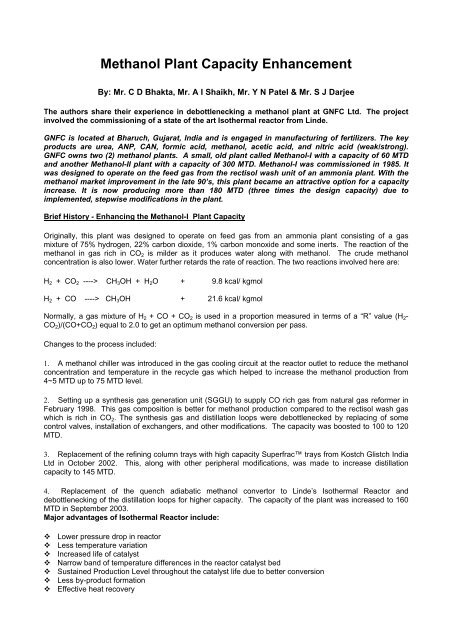Methanol Plant Capacity Enhancement By: Mr. C D ... - Fibre2fashion
Methanol Plant Capacity Enhancement By: Mr. C D ... - Fibre2fashion
Methanol Plant Capacity Enhancement By: Mr. C D ... - Fibre2fashion
You also want an ePaper? Increase the reach of your titles
YUMPU automatically turns print PDFs into web optimized ePapers that Google loves.
<strong>Methanol</strong> <strong>Plant</strong> <strong>Capacity</strong> <strong>Enhancement</strong><br />
<strong>By</strong>: <strong>Mr</strong>. C D Bhakta, <strong>Mr</strong>. A I Shaikh, <strong>Mr</strong>. Y N Patel & <strong>Mr</strong>. S J Darjee<br />
The authors share their experience in debottlenecking a methanol plant at GNFC Ltd. The project<br />
involved the commissioning of a state of the art Isothermal reactor from Linde.<br />
GNFC is located at Bharuch, Gujarat, India and is engaged in manufacturing of fertilizers. The key<br />
products are urea, ANP, CAN, formic acid, methanol, acetic acid, and nitric acid (weak/strong).<br />
GNFC owns two (2) methanol plants. A small, old plant called <strong>Methanol</strong>-I with a capacity of 60 MTD<br />
and another <strong>Methanol</strong>-II plant with a capacity of 300 MTD. <strong>Methanol</strong>-I was commissioned in 1985. It<br />
was designed to operate on the feed gas from the rectisol wash unit of an ammonia plant. With the<br />
methanol market improvement in the late 90’s, this plant became an attractive option for a capacity<br />
increase. It is now producing more than 180 MTD (three times the design capacity) due to<br />
implemented, stepwise modifications in the plant.<br />
Brief History - Enhancing the <strong>Methanol</strong>-I <strong>Plant</strong> <strong>Capacity</strong><br />
Originally, this plant was designed to operate on feed gas from an ammonia plant consisting of a gas<br />
mixture of 75% hydrogen, 22% carbon dioxide, 1% carbon monoxide and some inerts. The reaction of the<br />
methanol in gas rich in CO2 is milder as it produces water along with methanol. The crude methanol<br />
concentration is also lower. Water further retards the rate of reaction. The two reactions involved here are:<br />
H2 + CO2 ----> CH3OH + H2O + 9.8 kcal/ kgmol<br />
H2 + CO ----> CH3OH + 21.6 kcal/ kgmol<br />
Normally, a gas mixture of H2 + CO + CO2 is used in a proportion measured in terms of a “R” value (H2-<br />
CO2)/(CO+CO2) equal to 2.0 to get an optimum methanol conversion per pass.<br />
Changes to the process included:<br />
1. A methanol chiller was introduced in the gas cooling circuit at the reactor outlet to reduce the methanol<br />
concentration and temperature in the recycle gas which helped to increase the methanol production from<br />
4~5 MTD up to 75 MTD level.<br />
2. Setting up a synthesis gas generation unit (SGGU) to supply CO rich gas from natural gas reformer in<br />
February 1998. This gas composition is better for methanol production compared to the rectisol wash gas<br />
which is rich in CO2. The synthesis gas and distillation loops were debottlenecked by replacing of some<br />
control valves, installation of exchangers, and other modifications. The capacity was boosted to 100 to 120<br />
MTD.<br />
3. Replacement of the refining column trays with high capacity Superfrac trays from Kostch Glistch India<br />
Ltd in October 2002. This, along with other peripheral modifications, was made to increase distillation<br />
capacity to 145 MTD.<br />
4. Replacement of the quench adiabatic methanol convertor to Linde’s Isothermal Reactor and<br />
debottlenecking of the distillation loops for higher capacity. The capacity of the plant was increased to 160<br />
MTD in September 2003.<br />
Major advantages of Isothermal Reactor include:<br />
Lower pressure drop in reactor<br />
Less temperature variation<br />
Increased life of catalyst<br />
Narrow band of temperature differences in the reactor catalyst bed<br />
Sustained Production Level throughout the catalyst life due to better conversion<br />
Less by-product formation<br />
Effective heat recovery

















